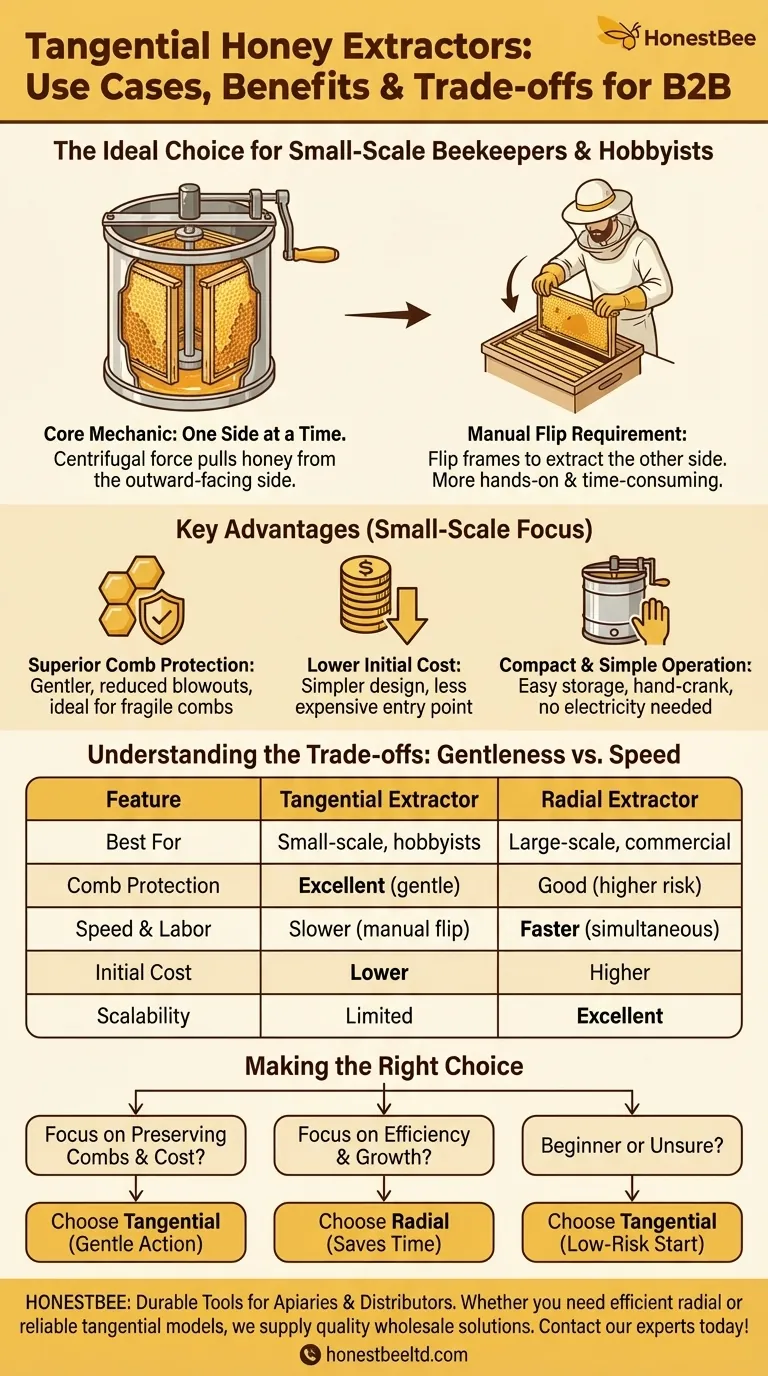In short, tangential honey extractors are the go-to choice for small-scale beekeepers and hobbyists. They are specifically designed for those with a limited number of hives, offering a cost-effective and gentle method for honey extraction where speed is not the primary concern.
The core decision comes down to a simple trade-off: tangential extractors prioritize honeycomb preservation and lower upfront cost, while their primary alternative, radial extractors, prioritize speed and efficiency for larger volumes.

How a Tangential Extractor Works
The Core Mechanic: One Side at a Time
A tangential extractor positions the frames so the flat side faces the outer wall of the drum. When the extractor spins, centrifugal force pulls honey out of the cells on that outward-facing side only.
The Manual Flip Requirement
Because honey is only extracted from one side, you must stop the process, manually flip each frame to face the other way, and then spin the extractor again. This makes the process inherently more hands-on and time-consuming.
Key Advantages for the Small-Scale Beekeeper
Superior Comb Protection
The primary benefit of a tangential extractor is that it is gentler on the honeycomb. The force is applied evenly across the surface, significantly reducing the risk of blowouts or damage, which is especially important for old, new, or fragile combs.
Lower Initial Cost
These extractors are typically simpler in design, smaller, and therefore less expensive than their radial counterparts. This makes them an accessible entry point for beginners or those operating on a tighter budget.
Compact and Simple Operation
Their smaller size, often holding between 2 and 9 frames, makes them easier to store and manage. Many are operated by a simple hand crank, removing the need for electricity and making them suitable for use in any location.
Understanding the Trade-offs: Gentleness vs. Speed
The Labor and Time Commitment
The most significant drawback is the manual labor involved. The need to flip every frame doubles the handling time and makes the extraction process considerably slower than other methods.
Limited Scalability
While perfect for a beekeeper with a few hives, the tangential method does not scale well. As your apiary grows, the time required for extraction can become a significant bottleneck.
The Radial Alternative
In contrast, radial extractors position frames like spokes on a wheel. Honey is thrown from both sides simultaneously, drastically cutting down on extraction time and labor. However, this method exerts more force on the combs and comes with a higher price tag.
Making the Right Choice for Your Goal
Before you invest, consider what you value most in your beekeeping operation.
- If your primary focus is preserving fragile combs and minimizing cost: A tangential extractor is the ideal choice, as its gentle action protects your bees' hard work.
- If your primary focus is efficiency and you manage more than a few hives: You will be better served by a radial extractor, which will save you significant time and labor.
- If you are a beginner and unsure of your long-term commitment: The lower cost and simplicity of a manual tangential extractor make it a low-risk starting point.
Ultimately, choosing the right extractor is about aligning the equipment's strengths with the scale and philosophy of your apiary.
Summary Table:
| Feature | Tangential Extractor | Radial Extractor |
|---|---|---|
| Best For | Small-scale beekeepers, hobbyists | Large-scale, commercial apiaries |
| Comb Protection | Excellent (gentle on fragile combs) | Good (higher risk of blowouts) |
| Speed & Labor | Slower (requires manual frame flipping) | Faster (extracts both sides simultaneously) |
| Initial Cost | Lower | Higher |
| Scalability | Limited | Excellent |
Ready to choose the perfect extractor for your apiary?
At HONESTBEE, we supply commercial apiaries and beekeeping equipment distributors with the durable, high-performance tools they need to succeed. Whether you're a growing commercial operation needing efficient radial extractors or a distributor serving hobbyists with reliable tangential models, our wholesale-focused operations provide the quality and value your business depends on.
Let's discuss your specific needs — contact our experts today to find the right equipment solution!
Visual Guide

Related Products
- 6 Frame Manual Stainless Steel Honey Extractor Beekeeping Equipment
- HONESTBEE 3-Frame Manual Acrylic Honey Extractor
- HONESTBEE 72 Frame Industrial Electric Honey Extractor for Beekeeping
- 2 Frame Stainless Steel Manual Honey Spinner Extractor for Beekeeping
- 24 Frame Honey Extractor Commercial Radial Honey Frame Extraction Machine
People Also Ask
- How many frames can different types of honey extractors hold? Maximize Your Harvest Efficiency
- What are the key stages of honey extraction? A Complete Guide for Beekeepers
- What are some tips for using a honey extractor effectively? Maximize Your Honey Yield and Protect Your Comb
- What tips can maximize honey extraction efficiency? Unlock Higher Yields and Purer Honey
- Which type of extractor is more suitable for hobbyists or small-scale beekeepers? Find the Perfect Fit for Your Apiary



















